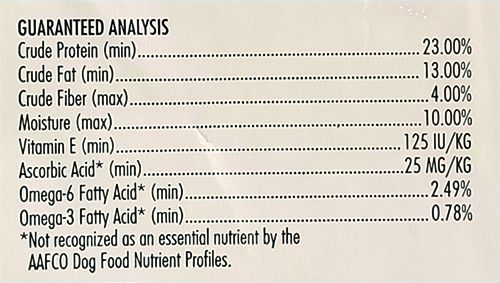
The guaranteed analysis (GA) is a highly regulated part of a pet food label, and the facts printed there are subject to surveillance and enforcement. State feed control officials may sample and test the product at any point in its production and sale; they often do visit stores and pull product from the shelf to test.
By federal law, the GA section of a pet food label must include four things: the minimum amounts of crude protein and crude fat and the maximum amounts of crude fiber and moisture in the food.
By the way, don’t be alarmed by the use of the word “crude” in the terms you will see in the GA (“crude protein,” “crude fat,” and “crude fiber”). In this case “crude” refers to the testing methods used to determine the amounts, not the nutrients themselves. The tests return a close approximation of the actual amount. It’s a subtle difference, and not terribly significant, so we use the terms without the crude prefix, as it were.
The four macronutrients that you will always find in the GA are there because they are considered important indicators of the food’s total value, with actual economic implications. Protein and fat are the most important (and most expensive) macronutrients for dogs, so both are expressed in minimum amounts; what’s being guaranteed is that the foods contain at least those amounts.
Be aware that the food may (and probably does) contain at least a little more protein and/or fat than the minimums listed in the GA. If you need to strictly limit your dog’s fat or protein, ask the manufacturer for a typical nutrient analysis – the result of a recent test of the varieties of food you are considering. Any pet food company who can’t or won’t produce this data probably shouldn’t be in the pet food business.
Carbs are not listed in the GA because they are not important to canine nutrition. Were you aware that dogs have zero nutritional requirements for carbohydrates? It’s true. Dogs can live and thrive on a diet that contains only protein and fat, with zero carbs. That said, dry foods do contain carbs; it’s impossible to make a kibble without carb sources. But you won’t find the actual percentage of the food that is carbohydrate on the GA.
Fiber and moisture are the other items in the GA. These are expressed in terms of their maximum presence in the food; you don’t want too much of either one! Most dry dog foods contain a maximum of 10% to 12% moisture. Any more moisture than that, and the kibble may experience bacterial growth. Less moisture and it won’t be very palatable.
The fiber content of dry dog foods tends to be more variable, which is interesting, because the AAFCO Dog Food Nutrient Profiles contain neither a minimum nor a maximum level; they don’t address fiber at all.
Most dry dog foods contain between 2.5% and 4.5%, although some “weight loss” or “lite” formulas might contain as much as 10% fiber. High fiber levels can interfere with the absorption of other nutrients in the food; diets with particularly low levels of fiber may contribute to the development of diarrhea, constipation, and/or problems with the dog’s anal glands. If your dog experiences any of these issues involving elimination, start paying attention to the amount of fiber in his diet. Consider a food with a higher amount of fiber than what you currently feed; if matters improve but he’s still not producing a nice firm (but not too hard) stool, look for a diet with an even higher fiber content, and, of course, discuss the issue with your veterinarian.
Manufacturers may (but are not required to) include other nutrients in the GA. The inclusion of a nutrient in the GA is a legal guarantee that the nutrient is present in those amounts in the food, and this is subject to testing and enforcement by state feed control officials. It’s a good way for pet food makers to validate claims of significantly increased amounts of certain nutrients, such as DHA (increased levels have neural benefits for puppies) or glycosaminoglycans (e.g., chondroitin, which has been shown to reduce arthritis symptoms).






What is the taurine level you should look for on the GA if the company opts to list it?
I am trying to learn as much as possible about the best food for my fur babies, Stella and Jack. I cook 1 meal a day for them and also feed a variety of freeze dried raw( Nutra Complete),air dried (Ziwi Peak), and Zignature dry food. They also get salmon oil and Nutra Thrive supplement powder. I feed them 3 eggs a week and raw fruit and veggies for snacks. I am presently reading “The Forever Dog” which has lots of information about feeding. I love reading WDJ as well! Thank you for your wonderful magazine!